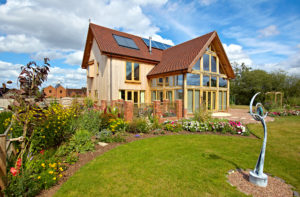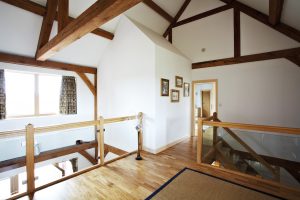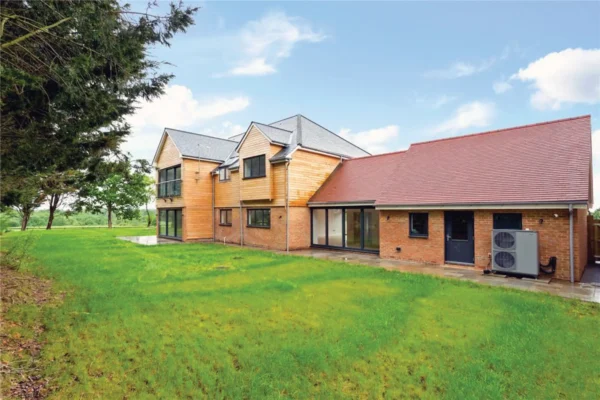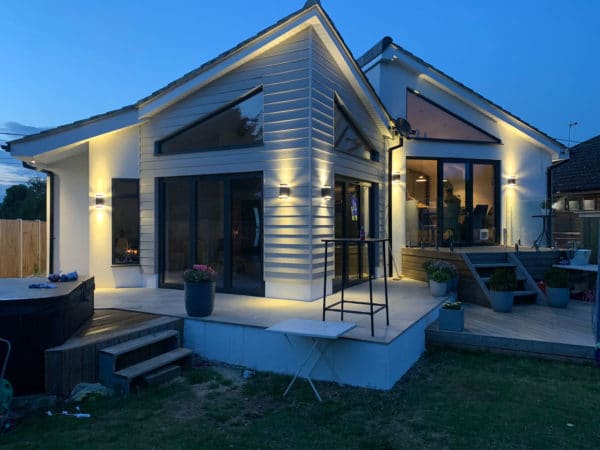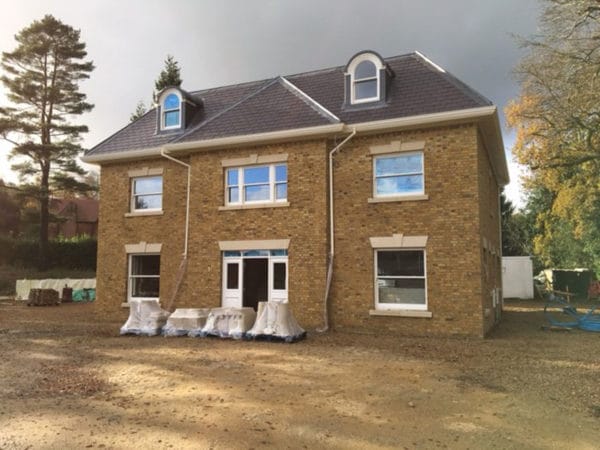Contemporary Oak Frame
In the countryside just outside Worcester, Helena and Martin Gloster’s new home stands in pride of place on a spacious plot next to an historic manor.
“We came across a bungalow for sale, and had lots of ideas in mind for what we could do with it. Before putting in an offer or moving forward we visited an architect who we’d used for some of our previous projects to discuss our ideas,” says Helena.
The design was for a new home on a plot nearby, next to a listed property. The owner of the listed dwelling needed to sell the land to raise funds for another project. “It ticked a number of our boxes, so we were happy just to modify certain aspects of the plans to suit our requirements,” says Helena.“We went through a very detailed description of what we hoped to achieve. He said ‘Do you mean something like this?’ and turned his computer screen round to show us almost exactly the house we wanted.”
Raising the frame
Although the basic design stayed the same, the Glosters overhauled the internal layout, swapping the north-facing glazed frontage for timber cladding (moving the glazed elevation to the rear).
- NameThe Glosters
- LocationWorcester
- ProjectSelf-build
- StyleContemporary
- Construction methodOak frame and SIPs
- House size310m²
- Land cost£210,000
- Build cost£365,000
- Cost per m²£1,177
- VAT reclaim£22,000
- Construction time54 weeks
The couple decided oak frame would provide them with the charm and character they desired. “After meeting Oakwrights we knew we wanted them to build the frame for us,” says Helena. “The design team were great; they really listened to us and responded to our needs.”
Martin led the project management, hiring various tradesmen, balancing the books, sourcing materials and labouring throughout. “An awful lot of the work in a self-build is the manual labour,” he says. “I can do that till the cows come home, so I employed tradesmen just to do the skilled bits.”
While the foundation work was going on, Martin and his builders, Mark and Tony, erected the oak frame garage. They wanted to get this finished early on, primarily because it would provide the workforce with welfare facilities – a kitchen and toilet – throughout the project.
Once the foundations were in place, Martin and the builders constructed a metre high brick wall round them. Oakwrights installed the frame inside this perimeter. “It only took them about four days to do that – three days to erect it and a day to square it up,” says Martin.
Efficiency first
From conception, the couple knew they wanted the house to be low maintenance and economical to run. “This is the last house we’re going to build so we wanted to make it efficient and minimise our utility bills,” says Helena.
“The oak frame has a structural insulated panel wraparound – from SIPs UK – to insulate the walls really well,” says Martin. “On the outside of all of the oak beams I’ve attached a 50mm x 50mm piece of timber, and the SIPs go on the outside of that, which means I can run my services behind the beams.”
Martin turned his hand to plumbing, too, installing underfloor heating throughout the house. “I’ve laid wet UFH pipes before so it was easy to do,” he says. “I took photos of everything as I went along, so I know where every piece of pipework is in the event that anything goes wrong.”
Although they were interested in heat pumps, Martin had concerns about the reliability of air source products over the winter, and found the cost of installing a ground source unit too prohibitive.
“We opted for an LPG system, which unfortunately meant we were marked badly for energy efficiency by the building inspector – even though our fabric-first approach means we barely need to use the heating anyway,” says Martin.
Renewable tech
The Glosters have fitted solar thermal and PV panels, a heat exchange and distribution system, a rainwater harvesting unit and a woodburning stove.
“Solar thermal systems should be built into every new home,” says Helena. “Ours is linked up to a decent sized tank so we have plenty of hot water. Last year, from the middle of February to September, we never once had to switch the boiler on.”
Upstairs, the woodburner is linked to a heat recovery system that distributes warmth evenly throughout the house. It’s proving extremely cost effective, as the couple are fuelling it for free with off-cuts from the build.
A rainwater harvesting tank buried in the garden is linked up to two of the toilets in the house, plus one in the garage and the outside taps. However, in hindsight, it’s one piece of kit that the couple wouldn’t install again.
“The amount of electricity used to pump the water from the tank to the house costs the same annually as you’re saving on water,” says Martin. “The system cost a few thousand pounds and we’ll never get payback. It’s nice to have but it’s not a money saving product.”
Light-filled interiors
Inside, the home is extremely bright thanks to a large open hallway and the sunroom, which is fitted with full height glazing. The hallway doubles up as a dining area and leads to the sunroom at the back of the house. To the right is the contemporary kitchen and utility area, and to the left are guest bedrooms, a main bathroom and the staircase.
“We have a plot that has fantastic views and we wanted to make the most of them, so instead of having most of the bedrooms upstairs, we put the living room and study area there. We have the master bedroom upstairs, too, so we get the best of both worlds,” says Helena.
Downstairs, the kitchen is the couple’s favourite area. The bespoke contemporary space is zoned off from the hallway with a laminated glass wall. “The glazed divide allows us to keep the light flowing through the house but separates the space for heat and comfort,” says Helena.
The Glosters had a near seamless build – apart from a minor issue with the glazing company, who initially sent the wrong products. However, this was easily resolved and the couple can revel in their attractive, efficient and comfortable new home.
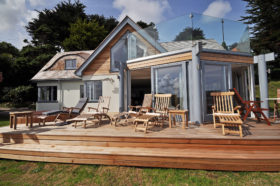
































































































 Login/register to save Article for later
Login/register to save Article for later

